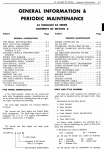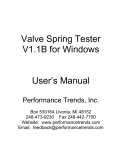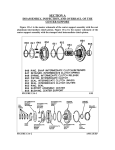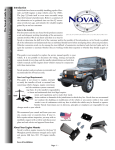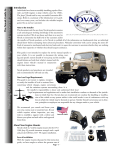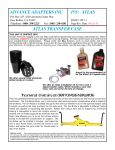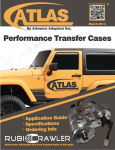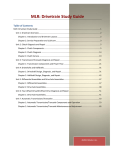Download This is an old draft of some TH400 oil pump
Transcript
This is an old draft of some TH400 oil pump technical information. Diagrams supplied by General Motors and ATSG have been noted and are the property of the credited entity. SECTION A DISASSEMBLY AND INSPECTION OF THE OIL PUMP Figure 10A-1 is the master schematic of the oil pump and related components. FIGURE 10A-1 GM Figure 10A-2 is the master schematic of the variable pitch oil pump cover and related components. FIGURE 10A-2 GM With variable pitch models, remove the two stator solenoid attaching screws, the stator solenoid, and the oil pump gasket. See Figure 10A-3. FIGURE 10A-3 GM Remove and discard the two oil seal rings (208) from the pump cover (202). 1964 to 1974 models were assembled with iron hook type rings. See Figure 10A-4. 1975 and up models received scarf cut Teflon type rings. Inspect the seal ring grooves for signs of wear or damage. See Figure 10A-5. Ring groove width should measure @ approximately .095”. Ring groove depth should measure @ approximately .090”. If the seal ring (s) is stuck or sticking in its groove, check for peening of the ring groove, and replace the pump cover if necessary. FIGURE 10A-4 PUMP COVER REAR FIGURE 10A-5 GM Remove the selective thrust washer (207) from the rear of the pump cover. See Figure 10A-6. Inspect the washer for signs of wear or damage. Place the stator shaft down thru a hole in the workbench and remove the five pump cover to pump body bolts (203,204,205). See Figure 10A-7. FIGURE 10A-6 FIGURE 10A-7 Remove the pump cover from the pump body (201). See Figure 10A-8. Use Figure 10A-10 as a guide for the removal of the pressure regulator assembly (211,212,213,214,215,216,217) from its bore in the pump cover. Mount the pump cover assembly in a padded vice to support it during removal of the pressure regulator assembly. Remove the retaining ring (211), the regulator boost valve bushing (212), the regulator boost valve (213), and the pressure regulator spring (214). See Figure 10A-9. CAUTION: THE PRESSURE REGULATOR SPRING IS TIGHTLY COMPRESSED AND WILL FORCE THE VALVE BUSHING OUT OF THE BORE WHEN THE SNAP RING IS REMOVED IF THE BUSHING IS NOT HELD SECURELY. DURING REMOVAL, KEEP PRESSURE ON THE ASSEMBLY AND RELEASE IT SLOWLY OUT OF THE BORE. FIGURE 10A-8 FIGURE 10A-9 GM FIGURE 10A-10 GM Remove the spring retainer washer (215), the spring spacer or spacers (216), and the pressure regulator valve (217). See Figure 10A-11. Remove the straight pin (219) and the valve bore plug (218). See Figure 10A-12. The bore plug exits from the straight pin side of the bore. FIGURE 10A-11 GM FIGURE 10A-12 GM Inspect the lands of the pressure regulator valve for signs of scoring or wear. See Figure 10A-13. Scoring may be a sign of excessive bore wear in the pump cover. This will be checked shortly. Prepare the pressure regulator valve by chucking up the outboard end of the valve in a cordless drill. See Figure 10A-14. The outboard end of the valve does not operate in the valve bore and will not become damaged by chucking it up in the drill. Lubricate the valve with penetrating oil, and polish the valve lands for 5 to 10 seconds with a fine scotch pad. Wash the valve with clean solvent and blow it dry with compressed air. The four lands on the pressure regulator valve should measure in @ .624” + or - .0005”. See Figure 10A-15. Note that there are first design and second design pressure regulator valves. Identify the type of pressure regulator valve in use. The first design valve contains oil holes, an orifice cup plug, and has no stem on the inboard end of the valve in comparison with the second design “solid” valve. See Figure 10A-16. Do not interchange pressure regulator valves without reviewing the information on Page ###. FIGURE 10A-13 FIGURE 10A-14 FIGURE 10A-15 FIGURE 10A-16 Inspect and prepare the regulator boost valve in the same manner as the pressure regulator valve. Inspect the bushing for signs of wear or damage. Fit the boost valve into the bushing and verify smooth in and out operation. Use a micrometer to measure the regulator boost valve lands. The small land on the boost valve should measure in @ approximately .482”. The large land on the boost valve should measure in @ approximately .604”. See Figures 10A-17 and 10A-18. FIGURE 10A-17 FIGURE 10A-18 Use pin gages to measure the bushing bore diameters. The small bore should measure in @ approximately .483”. See Figure 10A-19. The large bore should measure in @ approximately .605”. See Figure 10A-20. The recommended boost valve to bushing bore clearance is .0005” to .0012”. Subtract the measured boost valve land diameter value from the measured bushing bore diameter value to arrive at the boost valve to bushing bore clearance. Note that early models bushings are aluminum, and are prone to increased wear. FIGURE 10A-19 FIGURE 10A-20 Note that there are two extremely rare, smaller boost valve and bushing combinations that were used in the TH400 transmission. When encountered, use the same recommended clearance values stated. The measurements in this section are for the most common valve and bushing combination. The following information pertains to a bulletin regarding a mismachined regulator boost valve bushing. The mismachined part was installed in 1984 model year TH400 transmission between the Julian dates of 032 to 090. This machining error can result in the small land of the boost valve falling out of its bore in the bushing during transmission operation and sticking, resulting in high line pressure. As a result of high line pressure, the forward clutch backing plate snap ring may blow out of the forward clutch housing or the forward clutch piston may crack or blow out the lip seals. A list of possible models affected by this issue is provided. If the model being serviced cannot be identified by the serial number it is a good idea to measure the bushing to eliminate any chance of reinstalling a defective component. Inspect the pressure regulator spring for signs of distortion and collapsed coils. There are three versions of the production pressure regulator spring. Early models were plain in color, and later models were color coded either blue or white. See Figure 10A-21. Although the springs are all slightly different in appearance, they all share the same rate at the installed height. If you have access to a spring tester you can check the rate of the pressure regulator spring. At its installed height of 1.540”, all production pressure regulator springs should weigh in @ 17.5 pounds. Inspection of a production pressure regulator spring with the use of a specialty RIMAC spring tester is shown in Figure 10A-22. Rates of 18 and up pounds indicate an aftermarket pressure regulator spring has already been installed during prior service. FIGURE 10A-21 FIGURE 10A-22 With variable pitch models, remove the retaining pin, stator valve spring, and stator valve. See Figures 10A-23 and 10A-24. Inspect the spring for damage. Inspect the lands of the stator valve for signs of scoring or wear. Light scoring can be removed by lubricating the valve with penetrating oil and polishing the lands with a fine Scotch pad. Inspect the bore for signs of wear or damage. FIGURE 10A-23 GM FIGURE 10A-24 GM Inspect the splines of the stator shaft for signs of wear or damage. The splines should be square along their full length and free from scoring and galling. See Figure 10A-25. Note that early models were not produced with induction hardened splines and are prone to wear. Later models were produced with induction hardened splines, eliminating wear, and are easily identified by being black in color. If replacement is necessary, aftermarket stator shafts are available. Carefully inspect the pump cover face for any signs of damage or scoring. See Figure 10A-26. FIGURE 10A-25 FIGURE 10A-26 Use a whetstone and clean solvent to remove any burrs and create a flat, conditioned sealing surface. Generate a nice cross hatch pattern over the entire face of the pump cover. See Figure 10A-27. Place a precision straight edge across the machined face of the pump cover. Try to install a .001” feeler gage between the straight edge and the face to verify flatness. See Figure 10A-28. The feeler gage should not fit. If the gage fits, the face is warped. This requires resurfacing or replacement of the pump cover to maintain hydraulic integrity. Resurfacing is shown on PAGE###. If you will be replacing the pump body, be sure to check interchange information found on PAGE ###. FIGURE 10A-27 FIGURE 10A-28 Most 1964 to 1967 models are equipt with a cooler by-pass system. This system was intended to save the transmission internals from burn up due to lack of lube oil in the event that the transmission cooler became clogged or severely restricted. The resultant pressure increase in the system due to the blockage would open the cooler by-pass valve assembly and route the hot oil exiting the torque converter destined for the transmission cooler, directly to the transmissions lubrication circuit. By bypassing the cooler, the internal components would remain in a bath of oil, although hot oil, while the driver had enough time to make it to a service center for further analysis. This of course was providing that the driver somehow realized the transmission was overheating. Without an OEM transmission temperature gage installed in the vehicle, this would prove impractical for the average motorist. The sealing integrity of the by-pass valve can be checked by pouring a small quantity of mineral spirits into the valve pocket and checking for excessive leakage. Service parts are no longer readily available to repair a damaged by-pass assembly. If the assembly is found to be damaged, replace the pump body or remove the bypass assembly and install a cup plug in its place to isolate the two circuits from one another. If you have access to a replacement by-pass assembly, remove the seat by threading it with a 3/8-16 tap. Install a 3/8-16 threaded adapter on to a slide hammer and remove the seat, valve and spring. Install the replacement cooler bypass valve spring (large end first), the cooler by-pass valve, and the cooler by-pass valve seat into the pump cover. Use a 5/8” diameter rod to drive the seat flush with its bore in the pump body. The service manual procedure for by-pass assembly replacement is shown in Figures 10A-29 and 10A-30. FIGURE 10A-29 GM FIGURE 10A-30 GM Because most TH400 transmissions are used in high load applications, modifying the pressure regulation system for increased or fixed line pressure is common practice for increasing the torque capacity of the transmission. Because torque converter charge pressure is a derivative of line pressure, increases in line pressure result in increased converter charge pressure. If left as is, this increase in charge pressure acting on the inside of the torque converter can push the torque converter and flexplate forward into the engines crankshaft with enough force to quickly destroy the crankshaft’s main thrust bearing. Placing a restriction in the converter charge circuit eliminates the chances of this occurrence. The following modification should be performed on all TH400 transmissions with increased or fixed line pressure to reduce converter charge pressure to a safe level. Locate the converter charge passage in the pump cover. See Figure 10A-31. Using a 5/16-18 tap, thread the passage to a depth of approximately .250”. See Figure 10A-32. Source a 5/16-18 X 3/16 brass set screw. See Figure 10A-33. Install the set screw into the tapped hole. Be sure the set screw is installed to a depth below the pump cover face. Drill a new converter charge orifice thru the set screw. See Figure 10A-34. With production pressure regulator springs, drill orifice from .140” to .157”. With aftermarket pressure regulator springs, drill the orifice from .120” to .125”. FIGURE 10A-31 FIGURE 10A-32 FIGURE 10A-33 FIGURE 10A-34 With variable pitch models, be sure to check the turbine shaft sealing ring bore for wear or damage. It is located in the rear of the pump cover. See Figure 10A-35. Inspect the front (220) and rear (206) stator shaft bushings for sign of wear, scoring, pitting, or damage. Determine the stator shaft bushing to turbine shaft clearance. Carefully set a bore gage to the inside diameter of each bushing. See Figures 10A-36 and 10A-37. Use a micrometer to measure the gage. See Figure 10A-38. The bushing inside diameters should measure in @ .9990” to 1.0015”. If the bushings are not within specifications, replace them. In the absence of specialized measuring tools, another method can be used to determine stator shaft bushing to turbine shaft clearance. Install the turbine shaft (601) into the pump cover. Install the correct feeler gage that just fits in between the bushing and the shaft to obtain the clearance. See Figure 10A-39. The recommended clearance is .0005” to .0035”. If the clearance is not within specifications, replace the bushing(s). Both bushings are the same. Replacement bushing is shown in Figure 10A-40. Before removing stator bushings with variable pitch models, note/record the installed depth of the bushings as an assembly aid. FIGURE 10A-35 FIGURE 10A-36 FIGURE 10A-37 FIGURE 10A-38 FIGURE 10A-39 FIGURE 10A-40 Carefully cut the bushings from the stator shaft. See Figures 10A-41 and 10A-42. Use an arbor press and bushing driver to install the bushings. See Figure 10A-43. Install the front bushing to a depth of .250” below flush, and the rear bushing to a depth of .575” below flush. To verify the bushings have been installed properly, lube the bushings and install the turbine shaft (601) into the pump cover and verify smooth rotation. See Figure 10A-44. FIGURE 10A-41 FIGURE 10A-42 FIGURE 10A-43 FIGURE 10A-44 The service manual procedure for bushing replacement is shown in Figure 10A45. FIGURE 10A-45 GM Note that some high performance torque converters use what is commonly known as a “bushed turbine”. With this type of torque converter, the internal turbine is supported by a bushing in the torque converter front cover instead of by the input shaft and front stator shaft bushing. With this type of torque converter, the removal of the front stator shaft bushing is required. If the front stator bushing is not removed, the input shaft can be put into a bind during operation and can result in component damage. When aftermarket torque converters are in use, consult the manufacturer regarding their use of a bushed turbine. Use Figure 10A-46 as a guide to install the pressure regulator assembly into its bore in the pump cover. FIGURE 10A-46 GM Install the valve bore plug (218) and straight pin (219) into the pump cover. See Figure 10A-47. Lubricate and install the pressure regulator valve (217) into the pump cover (202). Install the pressure regulator spring spacer or spacers (216) and pressure regulator spring retainer washer (215) over the pressure regulator valve. See Figure 10A-48. Install the pressure regulator spring (214) into the bore and into engagement with the tabs on the retainer washer. Install the pressure regulator boost valve (213), stem end out, into the pressure regulator boost valve bushing (212). Keep them together with assembly lube. Install the assembly into the bore while at the same time compressing the spring enough so that the retaining ring (211) will enter its groove at the end of the bore. See Figure 10A-49. On models with the late pressure regulator valve, stroking of the pressure regulator valve can be checked by applying compressed air to the balance hole as shown in Figure 10A-50. FIGURE 10A-47 AMC/JEEP FIGURE 10A-48 FIGURE 10A-49 GM FIGURE 10A-50 GM On variable pitch models, lubricate and install the stator valve and spring into their bore in the pump cover and install the retaining pin. See Figures 10A-51 and 10A-52. FIGURE 10A-51 GM FIGURE 10A-52 GM Install the two oil seal rings (208) into their grooves on the rear of the pump cover. See Figure 10A-53. If scarf cut Teflon type rings are being installed, verify proper orientation of the ring end gaps as shown in Figure 10A-54. FIGURE 10A-53 GM FIGURE 10A-54 GM Disassembly of pump gears. Before removal, use a center punch or scribe to make an identification mark on the front face of both the drive (209) and driven gears (210) for proper orientation during reassembly. See Figure 10A-55. Remove the pump drive and driven gears from the pump body (201). See Figure 10A-56. Inspect the outside diameter, faces and gear teeth of both the drive and driven gears for signs of scoring, wear, or damage. See Figure 10A-57. Inspect the drive gear drive tangs and inside diameter of the drive gear for signs of scoring, wear or damage. See Figure 10A-58. Improper torque converter to flexplate clearance will usually result in damage to the driven gear at the interface between the drive tangs and the torque converter pump drive hub. FIGURE 10A-55 FIGURE 10A-56 FIGURE 10A-57 FIGURE 10A-58 GM Prepare the faces of both gears with a whetstone and clean solvent. Using a micrometer, measure and record the pump drive and driven gear thickness. See Figures 10A-59 and 10A-60. There is no published specification for the overall height of the gears; however production pump gears should measure in @ .7265” to .7275”. If the gears come up undersize, replacement will depend on the value obtained when measuring the pump body face to gear face clearance. Note that 1964 to 1966 fixed pitch model transmissions with a casting number of 1358649 use .625” thick gears. FIGURE 10A-59 FIGURE 10A-60 Inspect the pump gear pocket. Careful inspection of this area should not be overlooked. Failure to identify wear will result in reduced oil pump efficiency. Inspect the side wall of the gear pocket for any signs of scoring or abnormal wear. See Figure 10A-61. If any wear can be felt with your fingernail, the body should be replaced. Note that there is a tight tolerance between the outer diameter of the driven gear and the side wall of the gear pocket. The side wall acts as a bearing journal that supports the driven gear outside diameter on a fluid film during operation. Inspect the pump gear pocket face for any signs of scoring or abnormal wear. See Figure 10A-62. If any wear can be felt with your fingernail, the body should be replaced. FIGURE 10A-61 FIGURE 10A-62 Inspect the inside diameter of the crescent for any signs of scoring or abnormal wear. See Figure 10A-63. If any wear can be felt with your fingernail, the body should be replaced. Inspect the outside diameter of the crescent for any signs of scoring or abnormal wear. See Figure 10A-64. If any wear can be felt with your fingernail, the body should be replaced. FIGURE 10A-63 FIGURE 10A-64 Inspect the five pump body threaded bolt holes for stripped or damaged threads and repair if necessary. See Figure 10A-65. Carefully inspect the pump body face for any signs of damage or nicks that can result in hydraulic cross leaks between oil passages. See Figure 10A-66. FIGURE 10A-65 FIGURE 10A-66 It is recommended to replace the pump body bushing (3) during the initial overhaul, and then perform inspection during future service. Install the pump body (201) over the torque converter pump drive hub. Install the correct feeler gage that just fits in between the bushing and the hub to obtain the clearance. See Figure 10A67. The recommended clearance is .001” to .004”. If the clearance is not within specifications, replace the bushing. It is recommended to remove the bushing with the appropriate bushing driver. Always begin removal of the bushing at the seal end of the pump body, working towards the pump gear pocket. See Figure 10A-68. If you start removal at the pump gear pocket you will raise burrs that will create problems during assembly. Figure 10A-69 shows the pump body bushing and the pump body. Inspect the pump body bushing bore for any abnormal wear or evidence that the bushing may have spun out in the bore. See Figure 10A-70. If during removal, the bushing was loose in the bore, or the body shows signs of bushing spin out, the body must be replaced. FIGURE 10A-67 FIGURE 10A-69 FIGURE 10-68 GM FIGURE 10A-70 Inspect the bushing bore for the presence of burrs raised during bushing removal. If any burrs are present, remove them with a small file. Using a deburring tool, gently chamfer the front and rear entrances to the pump bushing bore. See Figures 10A-71 and 10A-72. FIGURE 10A-71 FIGURE 10A-72 Using a deburring tool, gently chamfer the front entrance to the driven gear pocket. See Figure 10A-73. Use a whetstone and clean solvent to remove any burrs and create a flat, conditioned sealing surface. See Figure 10A-74. Generate a nice cross hatch pattern over the entire face of the pump body. FIGURE 10A-73 FIGURE 10A-74 A lapping plate and the recommended lapping compound can also be used after the whetstone if you have access to one. Rest the machined surface of the pump body onto the plate. Using the weight of your hand, move the body in a figure eight pattern and note the resistance to motion. See Figure 10A-75. As the surface becomes conditioned, less resistance to attempted motion will be felt. After lapping, thoroughly clean all remaining traces of lapping compound. Place a precision straight edge across the machined face of the pump body. Try to install a .001” feeler gage between the straight edge and the face to verify flatness. See Figure 10A-76. The feeler gage should not fit. If the gage fits, the face is warped. This requires resurfacing or replacement of the pump body to maintain hydraulic integrity. Resurfacing is shown on PAGE###. If you will be replacing the pump body, be sure to check interchange information found on PAGE ###. FIGURE 10A-75 FIGURE 10A-76 Install the pump drive gear into the pump body. Install the correct feeler gage that just fits in between the outside diameter of the gear and the side wall of the gear pocket to obtain the clearance. See Figure 10A-77. The recommended clearance is .002” to .006”. Note that clearance should be checked even with new aftermarket gearsets, as most have been found to spec out @ .008” to .014”. Install the pump driven gear into the pump body. Install the correct feeler gage that just fits in between the inside diameter of the gear and the inside wall of the crescent to obtain the clearance. See Figure 10A-78. The recommended clearance is .002” to .0075”. FIGURE 10A-77 FIGURE 10A-78 Install the pump body bushing into the pump body. The replacement bushing is shown in Figure 10A-79. Note that this bushing does not like to be installed with a hammer and bushing driver. The use of an arbor press is recommended. Working from the seal end of the pump body, install the bushing flush with the top of its bore. See Figure 10A-80. To guarantee the bushing comes to a stop at the top of its bore the use of a bushing installer with an outside diameter larger than the bushing may be used. FIGURE 10A-79 FIGURE 10A-80 To verify the bushing has been installed properly, lube the bushing and install the pump body over the torque converter pump drive hub and verify smooth rotation. See Figure 10A-81. Check the fit of the replacement front pump seal (2) on the torque converter pump drive hub before installing it into the pump body. Verify the presence of the garter spring behind the rear end of the seal lip of the front pump seal. Pack the rear seal lip with grease prior to installation to avoid the garter spring being ejected during seal installation. Using a suitable method, install a new front pump seal into the pump body. See Figure 10A-82. FIGURE 10A-81 FIGURE 10A-82 Determine pump body face to gear face clearance. See Figure 10A-83. FIGURE 10A-83 GM Note that the published clearance values have been revised several times throughout the production of the GM TH400 transmission. Early General Motors service manuals, depending on car maker, stated either a clearance of .0007” to .0015” or .0008” to .0015”. This clearance was then revised to .0008” to .0035”, before the final revision recommending .0007” to .0026”. From my perspective, the preferred clearance is .0007” to .0015”. Extensive research has shown reduced pump pressure and volume result below 2500 RPM when the oil pump is assembled with clearances beyond .0015”. Install the gears into the pump body as shown in Figure 10A-84. FIGURE 10A-84 AMC/JEEP Place a precision straight edge across the machined face of the pump body, extending over the pump gears. Install the correct feeler gage that just fits in between the straight edge and gear face to obtain the pump body face to gear face clearance. See Figure 10A-85. FIGURE 10A-85 GM Clearance may also be obtained by measuring the gear pocket depth with a depth gage and subtracting the gear thickness from it. See Figure 10A-86. If the clearance is excessive, exchange the pump body or gear set. FIGURE 10A-86 Once the recommended clearance has been established, remove the pump gears from the pump body. To prevent pump damage from a dry start up, pack the pump gear pocket with assembly lube. With the identification mark facing up, reinstall the pump drive gear into the pump body. Reinstall the pump driven gear into the pump body with the drive tangs facing up. See Figure 10A-87. FIGURE 10A-87 GM Position the assembled pump body with the bushing bore over a hole in the workbench. See Figure 10A-88. Install the assembled pump cover over the pump body and align the bolt holes. See Figure 10A-89. FIGURE 10A-88 FIGURE 10A-89 Loosely install the five pump cover to pump body bolts (203,204,205). See Figure 10A-90. FIGURE 10A-90 GM On variable pitch models, the clip that retains the stator solenoid wire attaches to the “C” bolt adjacent to the stator valve. A longer bolt is used at this location. See Figure 10A-91. FIGURE 10A-91 GM To align the two pump sections, a pump alignment tool is used. Install and tighten the pump alignment tool around the outside diameter of the pump assembly. Be sure to align the thru holes in the body and cover for the pump to case bolts. This can be done with a tapered punch. The early service manual version is shown in Figure 10A-92. Note the stator solenoid wire retaining clip in the photo. A later version is shown in Figure 10A-93. FIGURE 10A-92 GM FIGURE 10A-93 GM In the absence of a pump alignment tool, the pump assembly may be installed upside down in its bore in the transmission case to align the two sections as shown in Figure 10A-94. Before installing the assembly into the case, be sure to remove any surface rust from the outside diameter of the assembly with a fine grit emery cloth. This will help to avoid the assembly becoming stuck in the transmission case. Torque the five pump cover to pump body bolts to 200 inch pounds. See Figure 10A-95. FIGURE 10A-94 GM FIGURE 10A-95 Place a TH400 torque converter flat on the bench with the pump drive hub facing up and install the oil pump assembly. Verify free rotation of the pump gears. See Figure 10A-96. On variable pitch models, install and align the pump to case gasket to the rear of the pump cover. Fit the stator solenoid to the pump cover with the attaching screws. See Figure 10A-97. Torque the attaching screws to 40 to 45 inch pounds. Attach the stator solenoid wire to the clip. FIGURE 10A-96 FIGURE 10A-97 GM SECTION 10 B RESURFACING/MACHINING OF THE PUMP BODY AND PUMP COVER If during inspection the pump cover or pump body faces are found to be out of specification, they can be resurfaced in a lathe to restore their original geometry. These operations can also be performed on known flat components for increased pump efficiency and improved sealing of the oil pump’s hydraulic circuits. When fitting a JW Ultra Bellhousing to a TH400 transmission, the front face of the oil pump should be machined parallel with the rear face of the bellhousing to provide a true mounting surface. The recommended methods for performing these operations are outlined in this section. Using a manual lathe, the front end of the pump body is picked up with precision soft jaws that attach to the inside diameter of the front pump bushing bore and bank against its front face. The pump body is then swept with a dial indicator to verify set up accuracy. The face of the pump body is then machined so that it is parallel and perpendicular to the bushing bore. Typically this operation will remove anywhere from .005” to .015” from the pump body face. See Figure 10B-1. Because material has been removed from the face, the pump gear pocket depth dimension will be reduced the same amount. FIGURE 10B-1 This will require a set of undersize pump gears be installed to restore proper pump body face to gear face clearence. To determine the required gearset thickness, the pump gear pocket depth is measured and recorded. See Figure 10B-2. From this dimension, the recommended pump body to gear clearance of .0007” to .0015” is subtracted and you arrive at the required pump gear thickness. Undersize pump gears were produced for the TH350 transmission and are readily available. .721”, .723”, and .725” sets are available. If the available gear sets will not drop in, the gear set may be surface ground to the proper dimension for the application. See Figure 10B-3. FIGURE 10B-2 If you will be installing a JW Ultra Bellhousing, perform this next operation. Without removing the pump body from the jaws, bring the facing tool to the pump to bellhousing mounting face and machine the mounting pad parallel to the pump body face. See Figure 10B-4. FIGURE 10B-4 Resurfacing the pump cover requires a different set up than the pump body. The rear end of the pump cover is picked up with precision soft jaws that attach to the forward clutch sealing ring boss outer diameter and bank against its face. At the front end, the front stator tube bushing is removed, and the tube is fitted with a precision plug and live center. The pump cover is then swept with a dial indicator to verify set up accuracy. The face of the pump cover is then machined so that it is parallel and perpendicular to the stator tube centerline. See Figure 10B-5. Without removing the pump, the facing tool is brought to the rear side of the pump cover and the gasket surface is machined. This ensures parallelism between the front and rear faces, as well as the transmission case. See Figure 10B-6. FIGURE 10B-5 FIGURE 10B-6 SECTION 10 C IDENTIFICATION AND INTERCHANGE OF THE PUMP BODY AND PUMP COVER Identify the type of oil pump body and oil pump cover in use. Note that all 1965 to 1967 Buick and Oldsmobile models and some 1965 to 1967 Cadillac and Rolls Royce models were produced with transmissions with the variable pitch feature. These models utilized a variable pitch specific oil pump. The pump is easily identified by the presence of a stator solenoid attached to the rear of the oil pump cover, as well as a short set of stator shaft splines. See Figures 10C-1 and 10C-2. FIGURE 10C-1 GM FIGURE 10C-2 GM The common casting number for the variable pitch pump cover is 8623761. See Figure 10C-3. The common casting numbers for the variable pitch pump bodies are 8623056 and 8623759. See Figure 10C-4. Note that all variable pitch pump bodies and pump covers are interchangeable. FIGURE 10C-3 GM FIGURE 10C-4 GM The first design early oil pump assembly was used in all 1964 to 1967 model year fixed pitch TH400 transmissions. The common casting number for the first design early oil pump cover is 8623073. See Figure 10C-5. The common casting numbers for the first design early oil pump bodies are 1358649 and 8624068. See Figure 10C6. The 8623073 oil pump cover can be mated with any 1964 to 1993 oil pump body. The 1358649 and 8624068 pump bodies can only be mated with the 8623073 pump cover. The first design early oil pump assembly uses eight pump to case mounting bolts. The second design early oil pump assembly was used in all 1968 to 1970 model year fixed pitch TH400 transmissions. The common casting numbers for the second design early oil pump covers are 8626174 or 8626176. See Figure 10C-7. The common casting number for the second design early oil pump body is 8626121. See Figure 10C-8. The 8626174 or 8626176 oil pump covers can be mated with any 1968 to 1993 oil pump body. The 8626121 pump body can be mated with any 1964 to 1993 pump cover. The second design early oil pump assembly uses eight pump to case mounting bolts. FIGURE 10C-7 GM FIGURE 10C-8 GM Close inspection of the second design early oil pump body shows that the assembly was carried over from the GM JETAWAY for use in the GM TH400. Several oil passages remained in the casting, although not used with the TH400. The use of the TH400 specific pump cover eliminated any issues encountered with the left over passages. The JETAWAY oil pump body is shown in Figure 10C-9 and the TH400 8626121 casting in Figure 10C-10. FIGURE 10C-9 GM FIGURE 10C-10 GM The late oil pump assembly was used in all 1971 to 1993 model year fixed pitch TH400 transmissions and featured all new castings. See Figures 10C-11 and 10C-12. The common casting numbers for the late oil pump covers are 8626896 and 8627000. The common casting numbers for the late oil pump body is 8626895. The 8626896 and 8627000 oil pump covers can be mated with any 1968 to 1993 oil pump body. The 8626895 pump body can be mated with any 1968 to 1993 pump cover. The 1971 to 1972 late oil pump assembly uses eight pump to case mounting bolts, and 1973 to 1993 models use six. Most 1973 and up late pump covers used stator shafts with heat treated stator shaft splines. FIGURE 10C-11 GM FIGURE 10C-12 GM The major change here was the removal of the pressure regulator valve balance hole from the regulator valve and its relocation to the pump cover casting. It is identified as the pressure regulator feed hole in Figure 10C-13. 1964 to 1970 models did not use this hole in the casting, as it was an integral part of the early pressure regulator valve. See Figure 10C-14. FIGURE 10C-13 GM FIGURE 10C-14 GM This permitted the use of a solid pressure regulator valve. This was probably done as a cost saving measure, as it eliminated the drilling and plugging operations performed to the regulator valve during the manufacturing process. See Figure 10C-15. FIGURE 10C-15 GM Never install the late solid pressure regulator valve in any 1964 to 1970 oil pump cover. The absence of the balance hole removes the systems self regulating feature and will instantly produce excessive line pressure resulting in immediate component failure. The early orifice plug pressure regulator valve can be installed in all pump covers. For ease of identification, the 1971 to 1993 late oil pump cover, with the added pressure regulator feed hole, features a squared off pressure regulator valve boss at the boost bushing end. See Figure 10C-16. When replacing or servicing the TH400 oil pump, the absence of the squared off pressure regulator valve boss in the pump cover casting should instantly alert you to verify the type of pressure regulator valve in use. FIGURE 10C-16 GM Figure 10C-17 is used to quickly verify the compatibility of a specific pump body and pump cover combination when interchanging components. FIGURE 10C-17 GM SECTION 10 E OIL PUMP DIAGRAMS Oil Pump Exploded View FIGURE 10E-1 GM Pump Cover Attaching Screws FIGURE 10E-2 GM Pump Cover to Cases Passages FIGURE 10E-3 GM Variable Pitch Pump Body and Pump Cover FIGURE 10E-4 ATSG Early Pump Body and Pump Cover FIGURE 10E-5 ATSG Late Pump Body and Pump Cover FIGURE 10E-6 ATSG

















































